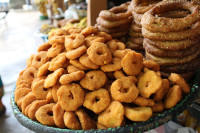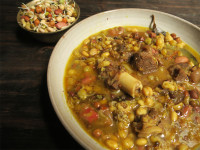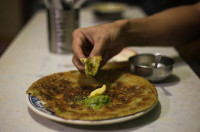Recipes
Rikikur: The Sherpa potato pancake
It's traditionally eaten at breakfast, but it's good for all times—especially now, with everyone locked inside.
Prashanta Khanal
What’s better to make use of, other than potatoes during this lockdown? Many who are privileged enough may have a stock of potatoes in their kitchen. If you love cooking, try making this savoury potato pancake ‘rikikur’—a loved dish of Sherpa community.
Potatoes are ingrained in Sherpa food culture, but it wasn’t always so. It was not until the mid 19th century that the potato was introduced to Sherpas in Khumbu, and it was not long until it became a staple. It contributed to the settled agrarian lifestyle and their economy—dried potatoes were even taken to Tibet to sell. From the Alps to the Himalayas of Nepal, the humble vegetable native to the South American Andes, helped communities like the Sherpa overcome famines, contributed to economic stability, and transformed their way of life. And, like those times, the humble tuber could be a saviour for hard times like now.
In the Sherpa kitchen, the potato is as basic as it can get, and it is cooked in every imaginable way. Potatoes are made into pancakes, dumplings, soups, stews, mashed and were even turned into flour and alcohol in the past. Boiled potatoes served with spicy achaar is a typical mid-day snack for people working in the fields.
Rikikur is a common breakfast dish for Sherpas. ‘Riki’ means potato and ‘kur’ is roti or bread in the Sherpa language, and the dish is just that: Finely grated potatoes mixed with a little flour and cooked in a pan. Traditionally, when modern graters weren’t available, rough surfaced stones were used as grater. Now, graters fashioned from steel plates are common in many a Sherpa family home.
A spicy achaar, generally made from serkam (a solid product resulting from the boiling buttermilk), accompanies the pancake. When available, somar (fermented serkam) or soshim (fermented clotted cream)—is added to make the achaar extra flavourful. Like fish sauce, they have strong aroma but when added in sparingly, it plays a transformative role, elevating the entire dish.
While it’s traditionally a breakfast dish, Rikikur can be eaten any time. The recipe is easy to make and doesn’t require a horde of ingredients. Also, when you have time during this lockdown, I encourage you to explore cuisines from across Nepal and teach yourself and kids about the importance of cooking.
Ingredients:
(Makes 4–5 rikikur)
8–10 potatoes, medium sized
3–4 tablespoons flour, buckwheat or plain white
1–2 eggs (optional)
Butter or oil for frying
For the achaar:
5–6 tbsps serkam, or thick yoghurt
1–2 stalks spring onion
3–4 cloves of garlic
1–2 green chillies
1 teaspoon salt
Directions:
Start with the achaar, if you don’t have serkam, use thick sour yoghurt instead. If the yoghurt is too thin, drain in a cotton cloth or large tea strainer until thick (approximately two hours). Grind spring onion, garlic, green chillies, and salt to make a paste, add to the yoghurt and mix.
Wash and peel the potatoes before finely grating (a food processor can be used in lieu of a grater). The finer, the better. Add flour to the potatoes, and mix to form a batter. Flour helps in binding. Eggs can be added now, although it’s not a traditional recipe, as the proteins will help bind the mixture further. Avoid adding salt as it makes the pancake soggy by drawing moisture from the grated potatoes.
Heat a frying pan and add a tablespoon of butter or oil. Add about half a cup of batter and spread evenly with a spoon. Cook both sides until golden brown. Serve with a small pad of butter and dollop of achaar. Eat it hot—cold rikikur has the off-taste of raw potato.




 18.37°C Kathmandu
18.37°C Kathmandu











